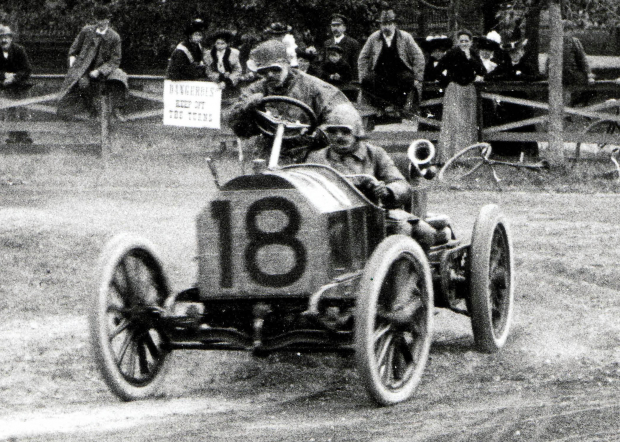Driver Profile: William Luttgen Part I: The 1904 Vanderbilt Cup Race

Lisa, thanks for the email. William Luttgen participated in four Vanderbilt Cup Races, three as a driver (1904, 1906, and 1908) and one as a mechanician (1905). According to the magazine Antique Automobile, when he died at the age of 88 in 1965, he was “the last living participant in the first Vanderbilt Cup Race”. Here is a profile of William Luttgen written with additonal information provided by you and the Luttgen family.
_____________________________________________________Wilhelm (William) Friedrich Balthazar Luttgen (1877-1965)
William Luttgen was born in 1877 in Ludwigsburg, Germany, just north of Stuttgart. His mother was poor and had to place William and his brother Karl in an orphanage. When the automobile was in its infancy, he became a mechanic and worked for Gottlieb Daimler whose company Daimler Motoren Gesellschaft (DMG) became selling cars in Stuttgart in the 1890s. Luttgen’s job was to deliver Mercedes to wealthy new buyers and teach their hired chauffeur and mechanics how to care for the new cars.
In 1903, one of Daimler’s customers was American sportsman Foxhall Keene who desired to drive his new Mercedes in European automobile road races. Keene took a liking to Luttgen and hired him as his mechanician for the Paris-Madrid Race (May 15-24, 1903) and the Gordon Bennett Race (July 2, 1903). In his autobiography “Full Tilt”, Foxhall Keene recalls the aid of William Luttgen:
“One of the fastest runs I ever made was not a race at all. I had entered my Mercedes in the Paris-Madrid race, and, the day before the cars were to be weighed by the government inspectors, I went around to see my car. It developed that, through a misunderstanding, my car had not been brought to Paris with the others. It was at Stuttgart, 500 miles away. The cars had to be weighed in the Tuileries Gardens by 7:30 the following evening. I caught a night train for Germany, arriving at 5:45 in the morning. My Mercedes was ready, but I had no papers giving me permission to take it across the frontiers. However my racing mechanic, Herr Luttgen, had his military papers, and I told him to show them and tell everyone who stopped us that I was his paid chauffer. This scheme worked, with Luttgen acting the big magnate and paying out money right and left whenever we were stopped. I drove into the Tuileries Gardes at 7:00 that evening.”
Keene and Luttgen’s were very lucky that their Mercedes broke down early in the Paris-Madrid race. Known as “The Race to Death”, at least six people lost their lives in this infamous race including Marcel Renault.
One month later, Keene entered the 1903 Gordon Bennett Race held on the 47-mile Althy Circuit, in County Kildare, Ireland. Keene and Luttgen made the fastest time of all the racers during the first lap averaging 52.2 miles per hour. However, just halfway through the 327.5 mile race, their Mercedes broke a rear axle and they finished ninth. One of Luttgen’s granddaughters recalls her grandfather’s experience with Keene:
“He didn't like driving with Foxhall Keene because of an incident in Ireland. Once they were driving on a country road and Keene hit a flock of geese. Foxhall didn't stop but kept on going. Grandpa turned around in his seat and looked back at the farmer holding a dead goose in his arms, which made Grandpa feel awful.”
William Luttgen got his big opportunity to become a driver at the first Vanderbilt Cup Race held on October 8, 1904 on the public roads of Long Island. Likely receiving a recommendation from Foxhall Keene, American banker Isidore Wormser hired Luttgen to drive his #18 60-HP Mercedes in the first international road race ever held in the United States.
Luttgen finished a respectable 7th of the 18 starters and had the second highest finish of the five Mercedes which entered the race. His granddaughter relates this story:
“Grandpa’s second (mechanician) was scared of going too fast and during races would call out to Grandpa to slow down . Grandpa would yell "Halt dein Mund!" (Hold your mouth!) repeatedly as he kept speeding along.”
Luttgen and his unhappy mechanician can be seen speeding through the Massapequa Turn at the one-minute six-second segment of the American Mutoscope and Biograph film of the 1904 race.








Comments
Times have changed. Here is an interesting tidbit published in the New York Times on October 7, 1904:
ARREST WORMSER CHAUFFEUR.
Banker’s Racer, Policeman Said, Was Going Thirty Miles an Hour.
Special to The New York Times.
Jamaica, N.Y., Oct. 6. - Chauffeur William Luttgen, who is in the employ of Isidor Wormser, Jr., one of the entrants for Saturday’s automobile race over Nassau County roads was arrested here this afternoon for overspeeding. Luttgen is an expert chauffeur. In a huge racing car with a large white perforated front, upon which the number 18 had been painted in figures 18 inches high, Luttgen and a machinist had been over the course and were returning to the city.
Even if it be proved that No. 18 exceeded the speed limit, it will not be barred out of Saturday’s race, it is said, as the owner was not in it, and as the machine was not on the race course.
Hi Robert:
Thanks so much for the New York Times article. The speeding incident happened one day before William Luttgen drove in the 1904 Vanderbilt Cup Race.
Enjoy,
Howard